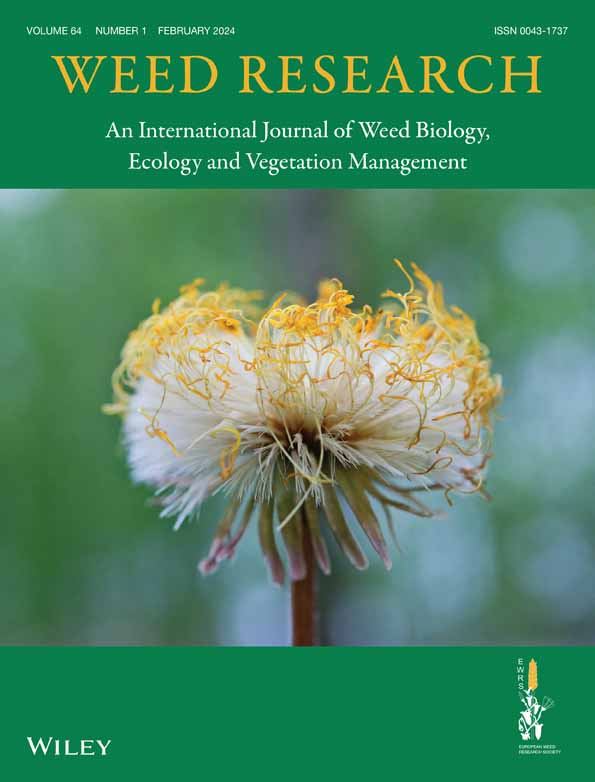Ver ítem
- xmlui.general.dspace_homeCentros Regionales y EEAsCentro Regional Buenos Aires SurEEA BarrowArtículos científicosxmlui.ArtifactBrowser.ItemViewer.trail
- Inicio
- Centros Regionales y EEAs
- Centro Regional Buenos Aires Sur
- EEA Barrow
- Artículos científicos
- Ver ítem
Herbicide-resistant weeds from dryland agriculture in Argentina
Resumen
We reviewed and performed a quantitative synthesis on herbicide-resistant weeds from rain-fed crops in Argentina. Twenty-four weed species distributed in the main extensive crops (soybean, maize, wheat, barley, oilseed rape, sunflower, chickpea and peanut) have evolved herbicide resistance. Of the total, 54% are grasses, 88% are annual species and 63% are cross-pollinated species. The most representative families were Poaceae with 54% resistant species,
[ver mas...]
We reviewed and performed a quantitative synthesis on herbicide-resistant weeds from rain-fed crops in Argentina. Twenty-four weed species distributed in the main extensive crops (soybean, maize, wheat, barley, oilseed rape, sunflower, chickpea and peanut) have evolved herbicide resistance. Of the total, 54% are grasses, 88% are annual species and 63% are cross-pollinated species. The most representative families were Poaceae with 54% resistant species, followed by Brassicaceae with 17%, and Asteraceae with 13%. Buenos Aires, Santa Fe and Córdoba were the provinces with the most documented cases of resistance (35%, 33% and 30%, respectively). The proportion of cases resistant to pre-emergence herbicides was 10%, whereas the proportion of cases resistant to post-emergence herbicides was 90%. Glyphosate was the herbicide with the highest incidence (92%) of resistance among weed species, followed by 29% of species that evolved resistance to ALS-inhibiting herbicides. Whereas resistance to auxin-like herbicides comprised 17% of the weed species, acetyl-CoA carboxylase (8%) and protoporphyrinogen oxidase (4%) inhibiting herbicides showed the least incidence of resistance evolution among weeds. The highest number of resistant species was identified in soybean (19), followed by maize (13), wheat/barley (10) and fallow (9). Weed species with a higher number of resistant populations to a higher number of herbicide mode of action were Amaranthus hybridus, A. palmeri, Lolium multiflorum and Raphanus sativus. The change in the production system since the mid-1990s, based on the use of herbicides (glyphosate mainly) to control weeds, is likely to account for the notorious increase in the average rate of evolution of herbicide-resistant weeds in Argentina.
[Cerrar]

Autor
Oreja, Fernando H.;
Moreno, Natalia;
Gundel, Pedro Emilio;
Vercellino, Roman Boris;
Pandolfo, Claudio Ezequiel;
Presotto, Alejandro Daniel;
Perotti, Valeria Elisa;
Permingeat, Hugo;
Tuesca, Daniel Horacio;
Scursoni, Julio Alejandro;
Dellaferrera, Ignacio Miguel;
Cortes, Eduardo;
Yanniccari, Marcos;
Vila-Aiub, Martín Miguel;
Fuente
Weed Research : 1-18. (First published: 21 January 2024)
Fecha
2024-01
Editorial
Wiley
ISSN
1365-3180
0043-1737
0043-1737
Formato
pdf
Tipo de documento
artículo
Palabras Claves
Derechos de acceso
Restringido
 Excepto donde se diga explicitamente, este item se publica bajo la siguiente descripción: Creative Commons Attribution-NonCommercial-ShareAlike 2.5 Unported (CC BY-NC-SA 2.5)
Excepto donde se diga explicitamente, este item se publica bajo la siguiente descripción: Creative Commons Attribution-NonCommercial-ShareAlike 2.5 Unported (CC BY-NC-SA 2.5)


